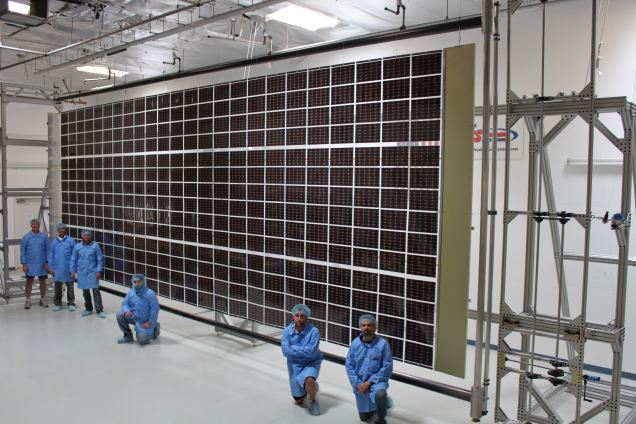
Roll Out Solar Array | Image: Deployable Space Systems via NASA
Stowed in the trunk of SpaceX’s Dragon capsule is an experimental roll-out solar panel array due to be launched today on a Falcon 9 rocket in a mission to the International Space Station.
NASA is keen to boost the capacity of solar power systems used on spacecraft; but it needs arrays that are cheaper, stronger, lighter and that can be compacted into a smaller space for launch.
The Roll Out Solar Array (ROSA) features solar panels deployed using the energy stored in high-strain one-piece composite slit-tube booms that also provide the array’s structural stiffness and strength.
Testing of ROSA will occur over 7 days, examining deployment and retraction of the array and various physical challenges to determine its strength and durability.
“ROSA has the potential to replace solar arrays on future satellites, making them more compact and lighter weight,” says NASA. “Satellite radio and television, weather forecasting, GPS and other services used on Earth would all benefit from high-performance solar arrays.”
A Brief Career For ROSA
According to SpacePolicyOnline, ROSA’s lifespan will be a very short one. After it is retracted into Dragon’s trunk housing; the trunk will detach from the capsule once Dragon reenters the Earth’s atmosphere. While Dragon will return to Earth in a splashdown off the coast of California, the trunk will burn up on reentry; detroying ROSA with it.
Aside from the solar aspect, another exciting element of this launch is it marks the first time a Dragon capsule has been re-used. SpaceX will also attempt to land Falcon 9’s first stage at Cape Canaveral Air Force Station.
The mission, SpaceX CRS-11, is set to launch at 5:55 p.m. USA EDT, (7.55 AM Australian Eastern Standard Time) and assuming things run to plan, Dragon will reach the ISS on Sunday (USA time).
UPDATE: The launch was postponed due to lightning near the Kennedy Space Center. It has been rescheduled to June 3, 2017 5:07 p.m. USA EDT.
UPDATE: On June 18, the roll out solar array was successfully deployed. The following video shows the process (actual ROSA deployment starts at 2 minutes into the video).
This will be the eleventh of fourteen resupply missions by SpaceX for NASA. SpaceX was founded in 2002 by Elon Musk, the man behind Tesla – manufacturers of the Powerwall solar battery system and the more recently announced Tesla solar roof product.
Large roll-out solar arrays also have terrestial potential; for use in applications including disaster relief, mining operations and providing power for festivals. UK company Renovagen has been developing a product that uses a vehicle to roll out a solar array up to to 16kWcapacity from a small trailer that also includes battery storage.
Closer to home, University of Newcastle unveiled its first printed solar demonstration site earlier this month, showcasing technology that enables solar panels to be quickly and economically printed in large rolls.

 RSS - Posts
RSS - Posts



Speak Your Mind